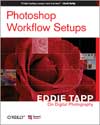
Photoshop Workflow Setups
by Eddie Tapp
197 pages
O’rielly Publishers
www.orielly.com
Any pro photographer, graphic designer, or web developer knows how important establishing a workflow is to effectively and efficiently completing projects, especially when it comes to working in mammoth programs like Adobe Photoshop CS2.
As both a student and developing professional of digital photography I’m discovering that as I learn how to better use Photoshop to improve my photographs and do design work, it’s equally important to know how to work and save time in PS so that the work can be done with as less frustration as possible.
As anyone who has spent some time working in PS, you know there are literally hundreds of menu items, tool selections, palettes, and features that either enhance your work or make you feel too overwhelmed to open the program and take advantage of what it can do.
To this end, a workflow is essential. In fact, I would say that anyone who works in PS and is not using a workflow system is wasting valuable time and is probably frustrated with the program.
Author, digital photographer, and lecturer Eddie Tapp, who this month was inducted into the Photoshop Hall of Fame at the Photoshop World Expo in Las Vegas, and who also serves as the Chairman of the Committee on Digital Advanced Imaging for Professional Photographers of America, has written the first in a series of books on effectively using Photoshop in the areas of professional color management, creative enhancement techniques, and professional production techniques.
His first book, Photoshop Workflow Setups: Customizing Photoshop for Digital Photography is part manual and part sharing of tips and strategies for using the basic tools, pallets, and features of PS. Unlike many other books on PS, he also includes chapters on using Adobe Bridge (installed with the CS2 package) as a image management program in conjunction with PS.
First off, I must say I thoroughly like the writing and layout of this book. The instructions are not verbose and each page layout includes single column text on the right and left side of each facing pages. Colorful screen shot illustrations make up the middle part of each facing pages with plenty of room for jotting notes. Additional tips are placed in yellow sticky-like notes that appear on almost every other page.
As I reference this book I often feel as though I’m reading a manual break down of each of PS’s tools, palettes, preferences, and menus and shortcuts. The explications for defining how to use each of these features is similar to what you might find in Adobe Photoshop’s Help files, however the writing is much clearer and friendlier to read. If for example, you look up the definition for “adjustment layers” in the Adobe Help files, the first definition starts of saying, “Adjustment layers and fill layers have the same opacity and blending options as image layers….” But in Tapp’s book, the definition starts this way: “Adjustment layers are some of the most powerful features in the Layer’s palette, allowing you to create various adjustments for color and tone on a layer rather than permanently changing the pixel data.” Here is when Tapp is at his best when he shares what he finds most useful in PS and how he as a PS expert makes the most effective use of particular tools, palettes, or features.
Much of this book is simple and straight forward, mainly because, I imagine, the varied types of readers that might use this book. Photoshop Workflow Setups will appeal most to novice and intermediate users of Photoshop who are not familiar with many of the preference and tool options often hidden away in PS. I’m not quite sure if this the first book in the series would appeal to more advance users of the program, for anyone who has completed a significant number of projects in PS no doubt is already familiar with many of the features that Tapp describes in this book.
Intermediate users of PS, like myself, though will find the book most useful. As I read through the chapters, I often open up PS and apply what I am learning from the book. Based on Tapp’s explanations, I have further customized some Preferences features, learned how to setup and save palette locations, how to attach History Logs to my image files, improve my understanding of the Actions features, and, among other things, have taken yet another look at Adobe Bridge as a way to manage my Photoshop and other Creative Suite projects.
If you’re not familiar with features like layer comps, font options, Version Cue, custom menu settings, XMP Sidecar Files, PS’s camera raw plug-in, smart guides, and vector tools then this book will also be of use to you.
However, Tapp doesn’t take much of a tutorial approach in this book, which is what I hope he will do in upcoming books in the series. Sometimes to really explain a powerful PS feature, you need to have readers open an image file and work through the steps. It’s not enough to just define what a feature does. Once users apply what they learn from a tutorial they will usually develop ownership of the process and can apply it again for similar projects.
Writing a book about Photoshop is no easy task and only an expert user like Tapp with with a conscious awareness of what students and professionals need to know when using the program can write a useful book such as this. Photoshop Workflow Setups is a very manageable book that can be referenced easily and will no doubt help novice and intermediate users make some significant inroads into this popular and powerful program.

Leave a Reply
You must be logged in to post a comment.